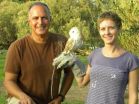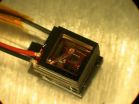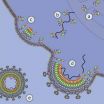(Press-News.org) BUFFALO, N.Y. -- Cyber attacks of various sorts have been around for decades. The most recent, and very dangerous, escalation in the past few years has been marked by countries launching attacks against other nations, such as Stuxnet, the nuclear plant-disrupting worm the Iranians have blamed on Israel and the U.S., while others are pointing the finger at Russia.
University at Buffalo military ethicist Randall R. Dipert, PhD, one of the founders of the National Center for Ontological Research at UB, says we have good reason to worry, because cyber attacks are almost entirely unaddressed by traditional morality and laws of war.
"The urge to destroy databases, communications systems and power grids, rob banking systems, darken cities, knock manufacturing and health-care infrastructure off line and other calamitous outcomes are bad enough," says Dipert.
"But unlike conventional warfare, there is nothing remotely close to the Geneva Conventions for cyberwar. There are no boundaries in place and no protocols that set the standards in international law for how such wars can and cannot be waged," he says.
"In fact," he says, "terms like 'cyber attack,' 'cyberwarfare' and "cyberwar,'" -- three different things with different characteristics and implications -- are still used interchangeably by many, although they are three distinct entities."
Dipert points out that while the U.S. isn't the only target, it is a huge target and "our massive systems offer the biggest payoffs for those who compromise them."
Dipert, C.S. Peirce Professor of American Philosophy at UB and a former West Point philosopher, examined many aspects of this issue in his paper "Ethical Issues of Cyberwarfare," first published on the website of the Consortium for Emerging Technologies, Military Operations and National Security, or CETMONS.
CETMONS is a multi-institutional organization concerned with the ethical, rational and responsible understanding and management of complex issues raised by emerging technologies, their use in military operations and their broader implications for national security. He presented a more comprehensive paper at the U.S. Naval Academy, which is due to be published soon by the Journal of Military Ethics.
Dipert points to a few of the many fronts on which the war has already begun: on components of U.S. defense cyber-infrastructure; cyber attacks by Russia on Estonia and Georgia; recent probable attacks by China, North Korea and Iran on U.S. defense and economic targets, well-organized attacks by China on corporate targets, Google and Gmail; and this month, the suspected Stuxworm attacks.
"There has been intentional cyberharm for decades," he says, "including damage perpetrated by apolitical and anarchic ("black") hackers and economically motivated industrial cyberespionage agents."
We think we have some idea of what "can" happen, but Dipert says, but there is a large array of possible scenarios for which there do not exist obvious moral reasoning or even straightforward analogies that could guide us.
"For instance," he says, "traditional rules of warfare address inflicting injury or death on human targets or the destruction of physical structures. But there are no rules or restrictions on 'soft-' or 'cyber-' damage, damage that might not destroy human beings or physical structures as objects.
"But," he says, "intentional destruction or corruption of data and/or algorithms and denial-of-service attacts could cause tremendous harm to humans, machines, artificial systems or the environment -- harm that could make entirely civilian systems that are necessary for the well being of the population inoperable for long periods of time.
"Second," he says, "I am disturbed by the extent to which, through easy Internet access, much of our economic and defense informatics infrastructure is vulnerable to cyber attack.
"This is due, in part," Dipert says, "to our departure from the relatively secure Arpanet (one of the networks that came to compose the global Internet) for use in defense operations to a wide-open Internet that doesn't have one relatively secure hard-wired Ethernet portal, but a variety of possible portals accessible by numerous international routes.
"Third," Dipert says, "Gen. Keith Alexander, director of the National Security Agency, who also heads Cyber Command, a new full command instituted by the U.S. Department of Defense, has indicated that serious thought is being devoted to the development of cyberwarfare policy and strategy.
"To date, however, this has been shrouded in secrecy," he says, "which is a serious problem because if they are to have a deterrent effect, it is absolutely necessary to make some policy elements public."
Finally, Dipert points out that cyberwarfare is such a new and difficult domain that traditional ethical and political theories with which we frame disputes -- utilitarianism, Kantian theory or natural rights theory -- cast little light on this particular one.
Dipert says, "It has been my working assumption that to fully understand the moral constraints of warfare requires us to understand certain conclusions from game theory and work them into traditional thinking about war."
He points out that similar reasoning in game theory guided the nuclear powers through the earlier years the Cold War, when there was little idea of how to use these weapons defensively or offensively.
What we need today, he says, and what scholars, military personnel and governments are trying to come up with, are policies, doctrines and strategies that cover cyberwarfare; an understanding of Just War Theory for cyberwarfare; new concepts and principles of morality for cyberwarfare; and some agreement as to whether and how such warfare is subject to international and customary law.
Dipert says, "I would predict that what we face today is a long Cyber Cold War, marked by limited but frequent damage to information systems, while nations, corporations and other agents test these weapons and feel their way toward some sort of equilibrium."###
The University at Buffalo is a premier research-intensive public university, a flagship institution in the State University of New York system and its largest and most comprehensive campus. UB's more than 28,000 students pursue their academic interests through more than 300 undergraduate, graduate and professional degree programs. Founded in 1846, the University at Buffalo is a member of the Association of American Universities.
END
Anxiety, or the reaction to a perceived danger, is a response that differs from one animal or human to another ― or so scientists thought. Now researchers at Tel Aviv University are challenging what we know about stress, and their study has implications for helping clinicians better treat victims of terrorism or natural disasters.
Prof. David Eilam and his graduate student Rony Izhar of Tel Aviv University's Department of Zoology are spearheading a study designed to investigate the anxieties experienced by an entire social group. Using the natural predator-and-prey ...
Researchers from the National Institute of Standards and Technology (NIST) and the German national metrology institute have used NIST's miniature atom-based magnetic sensor to successfully track a human heartbeat, confirming the device's potential for biomedical applications.
Described in Applied Physics Letters,* the study is the first to be performed under conditions resembling a clinical setting with the NIST mini-sensors, which until now have been operated mostly in physics laboratories. The new experiments were carried out at the Physikalisch Technische Bundesanstalt ...
TORONTO, ON – Evolutionary biologists at the University of Toronto (U of T) have found that environment plays a key role in determining whether a species opts for sexual over asexual reproduction.
The study, led by post-doctoral student Lutz Becks and Professor Aneil Agrawal of the Department of Ecology & Evolutionary Biology, found that species that inhabit spatially heterogenous environments – habitats characterized by uneven concentrations of its own species among a rich variety of other animals and plants – had higher rates of sexual reproduction than those in more ...
A paper by researchers at the National Institute of Standards and Technology (NIST) may breathe new life into the use of a powerful—but tricky—diagnostic technique for cell biology. The paper,* appearing this week in the Biophysical Journal, demonstrates that with improved hardware and better signal processing, a powerful form of molecular vibration spectroscopy can quickly deliver detailed molecular maps of the contents of cells without damaging them. Earlier studies have suggested that to be useful, the technique would need power levels too high for cells.
The technique, ...
New insights into the human immunodeficiency virus (HIV) infection process, which leads to acquired immunodeficiency syndrome (AIDS), may now be possible through a research method recently developed in part at the National Institute of Standards and Technology (NIST), where scientists have glimpsed an important protein molecule's behavior with unprecedented clarity.
The HIV protein, known as Gag, plays several critical roles in the assembly of the human immunodeficiency virus in a host cell, but persistent difficulties with imaging Gag in a lab setting have stymied researchers' ...
CHAMPAIGN, Ill. – A new law aimed at helping stimulate small business job growth through tax deductions could have major consequences for anyone with a retirement savings account at work, a University of Illinois expert on taxation and elder law notes.
Law professor Richard L. Kaplan says an obscure provision in the recently enacted Small Business Jobs Act allows 401(k), 403(b) or 457 account holders to convert their retirement savings into a tax-advantaged Roth-version of the same account.
The good news, according to Kaplan, is that by converting to a Roth variant, ...
Researchers at the National Institute of Standards and Technology (NIST) have demonstrated* for the first time the conversion of near-infrared 1,300 nm wavelength single photons emitted from a true quantum source, a semiconductor quantum dot, to a near-visible wavelength of 710 nm. The ability to change the color of single photons may aid in the development of hybrid quantum systems for applications in quantum communication, computation and metrology.
Two important resources for quantum information processing are the transmission of data encoded in the quantum state of ...
Removing the toxic and odorous emissions of ammonia from the industrial production of fertilizer is a costly and energy-intensive process. Now, researchers in Bangladesh have turned to microbes and inexpensive wood charcoal to create a biofilter that can extract the noxious gas from vented gases and so reduce pollution levels from factories in the developing world.
Writing in the International Journal of Environment and Pollution, Jahir Bin Alam, A. Hasan and A.H. Pathan of the Department of Civil and Environmental Engineering, at Shahjalal University of Science and Technology, ...
JACKSONVILLE, Fla. — Physicians at Mayo Clinic's Florida campus are among the first in the nation to use a technique known as MRI-guided laser ablation to heat up and destroy kidney and liver tumors. So far, five patients have been successfully treated — meaning no visible tumors remained after the procedure.
They join their colleagues at Mayo Clinic's site in Rochester, Minn., who were the first to use laser ablation on patients with recurrent prostate tumors.
Although the treatment techniques are in the development stage, the physicians say the treatment is potentially ...
Personalized medicine — improving the fit between patient and treatment — has become a major focus of research in fields from cancer treatment to the psychopharmacology of mental disorders. Genetic studies have suggested that an individual's genetic makeup renders him either more or less sensitive to stressful social environments — but can an individual's unique genotype also determine the effectiveness of preventative or therapeutic behavioral interventions?
The current issue of Perspectives on Psychological Science, a journal of the Association for Psychological Science, ...





